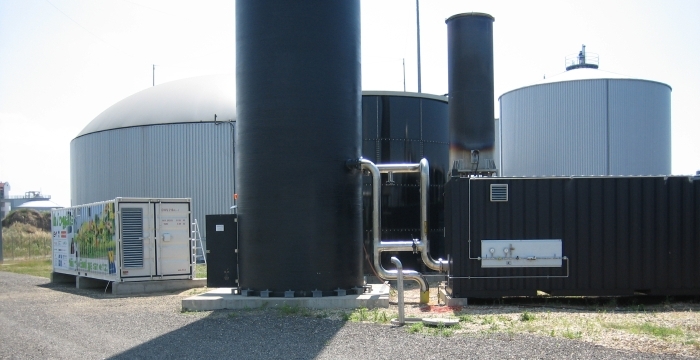Membrane Biogas Upgrading
Biogas is a combustible gas mixture that is produced by the fermentation of biomass. The typical fermentation substrate is sewage sludge, organic waste or food waste, manure, agricultural waste (such as cover crops, crop residues etc.), as well as specially cultivated energy plants (renewable raw materials). Biogas is produced by the microbial degradation of organic matter under anaerobic conditions.
Biogas can be used for electricity and heat production in a CHP gas engine, or it can be cleaned in a biogas upgrader to reach the same quality as fossil-derived natural gas and then injected into the natural gas grid or used as vehicle fuel (Bio-CNG). If fed into the natural gas grid, the upgraded biogas (often referred to as biomethane) is obliged to fulfil the quality criteria defined by the relevant laws, e.g. the ÖVGW G31 and G33 in Austria. If used as fuel for CNG -vehicles, different regulations apply, e.g. the BGBL 417-II 2004. The table below compares biogas composition with standardized compositions of natural gas and CNG.
| Parameter | Unit | Raw biogas (typical values) |
Gas quality for grid injection according ÖVGW G31/G33 |
Gas quality for fuel purposes according BGBL 417-II 2004 |
|---|---|---|---|---|
| Methane content | [mol%] | 40 to 80 | ≥ 97,0 (absence H2) * | ≥ 89,5 (absence H2) * |
| Carbon dioxide content | [mol%] | 14 to 55 | ≤ 2,0 | unspecified |
| Ammonia content | [mg/m³STP] | ≤ 1.000 | technically free | unspecified |
| Hydrogen sulphide content | [mg/m³STP] | ≤ 2.000 | ≤ 5,0 | unspecified |
| Oxygen content | [mol%] | ≤ 2,0 | ≤ 0,5 | unspecified |
| Nitrogen content | [mol%] | ≤ 20,0 | ≤ 5,0 | unspecified |
| Water content (dewpoint) | [°C] | < 37 @ 1 bar | ≤ -8 @ 40 bar | unspecified |
| Upper heating value | [kWh/m³STP] | 6,0 to 9,3 | 10,7 to 12,8 | 8,4 to 13,1 |
| Wobbe-index | [kWh/m³STP] | 6,0 to 11,1 | 13,3 to 15,7 | 12,1 to 15,7 |
| Relative density | [-] | 0,70 to 1,20 | 0,55 to 0,65 | 0,55 to 0,70 |
*…not directly specified, but calculated from other specified parameters (upper heating value or Wobbe-index)
In order to fulfil the obliged quality criteria, malicious substances like hydrogen sulphide, VOC or ammonia, water vapor and the main contaminant carbon dioxide have to be removed from biogas. Thus, the heating value of biogas is significantly increased and the Wobbe-index is adjusted so that the combustion behavior of the produced biomethane is similar to the one of fossil natural gas. As a result, the biomethane can be used as a carbon-dioxide-neutral biogenous substitute of the fossil natural gas.
Axiom has over twenty-five years of experience in membrane technology and entered the business of biogas upgrading in 2001 with first pilot trials together with Vienna University of Technology. After continuous research, optimisation and process improvement performed by these two partner organisations, membrane-based biogas upgrading systems of Axiom can be nowadays distinguished from another biogas upgrading processes by:
- low energy consumption
- high methane recovery (up to 99,8%)
- technological possibility of ultra low methane slip < 0,2 % in relation to methane input according to legal requirements
- very small size of upgrading plants
- high process safety and simplicity for operators

Figure: The first industrial-scale biogas upgrading plant in Austria in Bruck/Leitha: Membrane separation technology supplied by axiom
